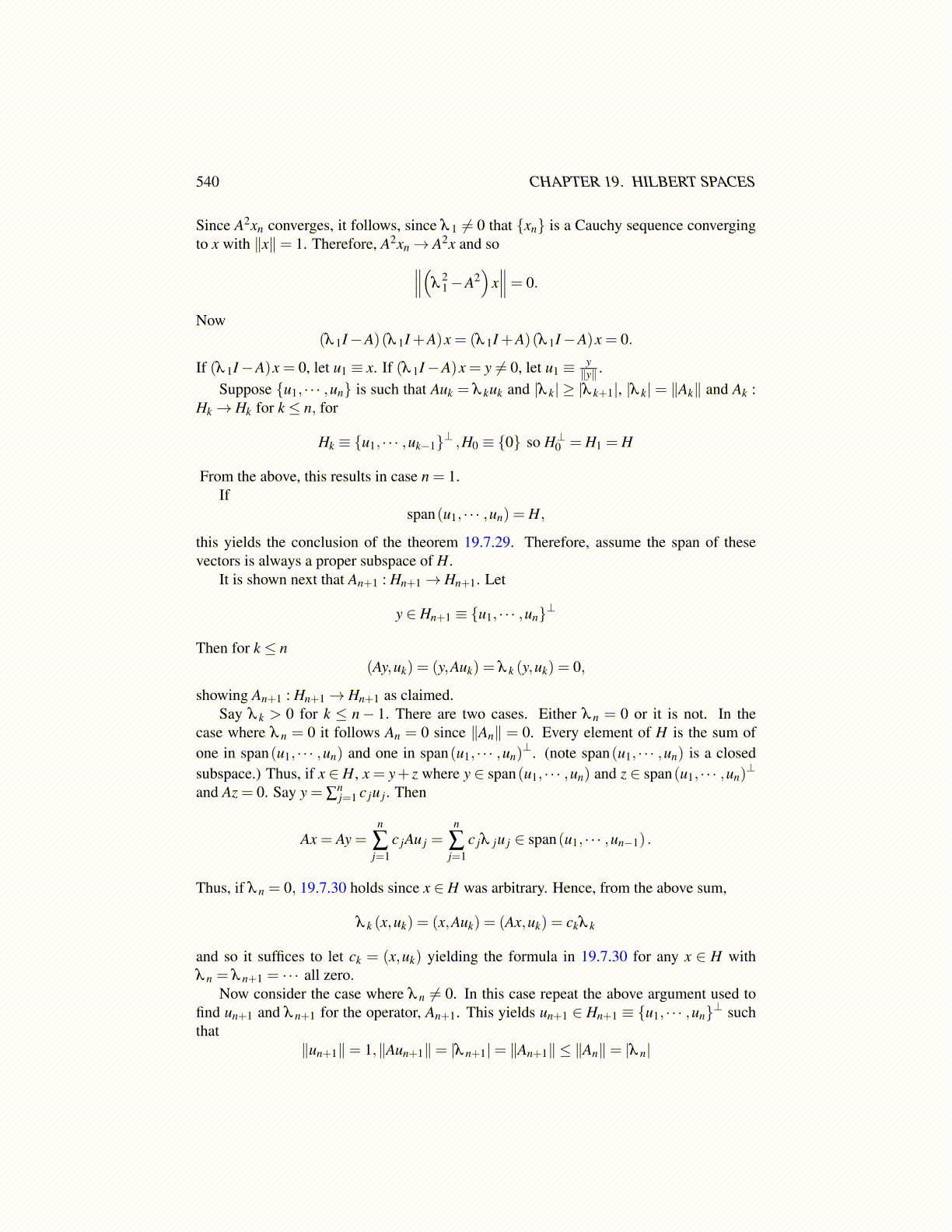
540 CHAPTER 19. HILBERT SPACES
Since A2xn converges, it follows, since λ 1 ̸= 0 that {xn} is a Cauchy sequence convergingto x with ∥x∥= 1. Therefore, A2xn→ A2x and so∥∥∥(λ
21−A2
)x∥∥∥= 0.
Now(λ 1I−A)(λ 1I +A)x = (λ 1I +A)(λ 1I−A)x = 0.
If (λ 1I−A)x = 0, let u1 ≡ x. If (λ 1I−A)x = y ̸= 0, let u1 ≡ y∥y∥ .
Suppose {u1, · · · ,un} is such that Auk = λ kuk and |λ k| ≥ |λ k+1|, |λ k| = ∥Ak∥ and Ak :Hk→ Hk for k ≤ n, for
Hk ≡ {u1, · · · ,uk−1}⊥ ,H0 ≡ {0} so H⊥0 = H1 = H
From the above, this results in case n = 1.If
span(u1, · · · ,un) = H,
this yields the conclusion of the theorem 19.7.29. Therefore, assume the span of thesevectors is always a proper subspace of H.
It is shown next that An+1 : Hn+1→ Hn+1. Let
y ∈ Hn+1 ≡ {u1, · · · ,un}⊥
Then for k ≤ n(Ay,uk) = (y,Auk) = λ k (y,uk) = 0,
showing An+1 : Hn+1→ Hn+1 as claimed.Say λ k > 0 for k ≤ n− 1. There are two cases. Either λ n = 0 or it is not. In the
case where λ n = 0 it follows An = 0 since ∥An∥ = 0. Every element of H is the sum ofone in span(u1, · · · ,un) and one in span(u1, · · · ,un)
⊥. (note span(u1, · · · ,un) is a closedsubspace.) Thus, if x ∈ H, x = y+ z where y ∈ span(u1, · · · ,un) and z ∈ span(u1, · · · ,un)
⊥
and Az = 0. Say y = ∑nj=1 c ju j. Then
Ax = Ay =n
∑j=1
c jAu j =n
∑j=1
c jλ ju j ∈ span(u1, · · · ,un−1) .
Thus, if λ n = 0, 19.7.30 holds since x ∈ H was arbitrary. Hence, from the above sum,
λ k (x,uk) = (x,Auk) = (Ax,uk) = ckλ k
and so it suffices to let ck = (x,uk) yielding the formula in 19.7.30 for any x ∈ H withλ n = λ n+1 = · · · all zero.
Now consider the case where λ n ̸= 0. In this case repeat the above argument used tofind un+1 and λ n+1 for the operator, An+1. This yields un+1 ∈ Hn+1 ≡ {u1, · · · ,un}⊥ suchthat
∥un+1∥= 1,∥Aun+1∥= |λ n+1|= ∥An+1∥ ≤ ∥An∥= |λ n|